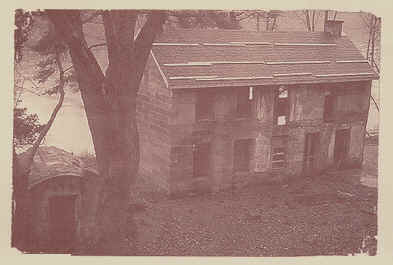The architecture of the various historic structures still standing in Ohio continues to serve as a reflection of the diverse cultural traditions of the European immigrants who carved towns, farms and industries out of the Ohio wilderness. The great forests provided free and plentiful timber for the log cabins and more finely crafted log houses that began to dot the frontier landscape in the 18th and early 19th centuries. The designs of these structures and the tools needed for their construction were simple enough to allow families fresh from the hardships of pioneer travel to make their own home-made shelters.
For the European settlers who once named as their homes the tree-barren meadows, rocky crags and rolling terrain of Ireland, Scotland and Wales, the Ohio country provided lands on which to farm and to mine iron, stone or coal. All along the foothills of the Appalachians where many of them chose to stay, native sandstone lies barely hidden just below the earth. Occasionally, it juts up through the earth's surface in the form of great cliffs, ledges and cave-like rock shelves. The Celtic immigrants brought with them memories of the stone cottages and castles common to the British Isles, along with the skills to build them. Thus, the Scotch-lrish influence on early American architecture is exhibited in the stone fireplaces and chimneys of "American" log cabins, as well as in the more rare stone homes that required great effort and craftsmanship to construct.
One such stone treasure rises like some ancient ruin from a small clearing in the forest of Salt Fork State Park. In 1837, Benjamin Kennedy, formerly of Ireland, purchased an 80-acre tract of land in Guernsey County and commissioned the construction of a large two-story stone house from native sandstone quarried nearby. The Kennedy Stone House is forty feet long and eighteen feet wide, built of stone blocks up to nine feet long and fourteen inches in width and height. The blocks used in the construction of the house were finely crafted and tightly fitted, exhibiting the kind of superior workmanship that has become something of a lost art in our present age. The house and a stone fruit cellar nearby were constructed for a total price of about $600 — quite a bargain, even in those days.
The Kennedy Stone House was home to several generations of Kennedy descendants ending with Don Kennedy, the great-grandson of the builder, who occupied it until 1966. The state of Ohio purchased the Kennedy property and surrounding lands to create Salt Fork State Park, and in 1967, the valley below the house was impounded to create Salt Fork Lake. Today, the house overlooks the lake and is nestled in the woods, accessible only by foot or by boat. The Kennedy Stone House was listed on the National Register of Historic Places in 1975, signifying its importance to history.
After sitting vacant for nearly 30 years, the roof of the Kennedy Stone House was damaged when a limb fell from a massive pine tree planted near the house by Benjamin Kennedy. The Salt Fork park staff had been concerned for some time about deterioration of the structure, so this incident prompted quick action. The park staff found that the local community shares their vision to rescue and preserve this unique historic landmark. The project has been a true team effort with all segments of the park staff working together with the local community and pooling resources. Over the next few years, the park staff and interested citizens hope to restore the interior of the Kennedy Stone House to its original condition.